Mobile Energy Storage Battery
20 – 100 kWh
Experience unmatched overload capability of up to 200% and virtually maintenance-free operation. Tailored for optimal short cycle performance and offering a large usable energy range compared to other technologies, this battery ensures a low total cost of ownership.
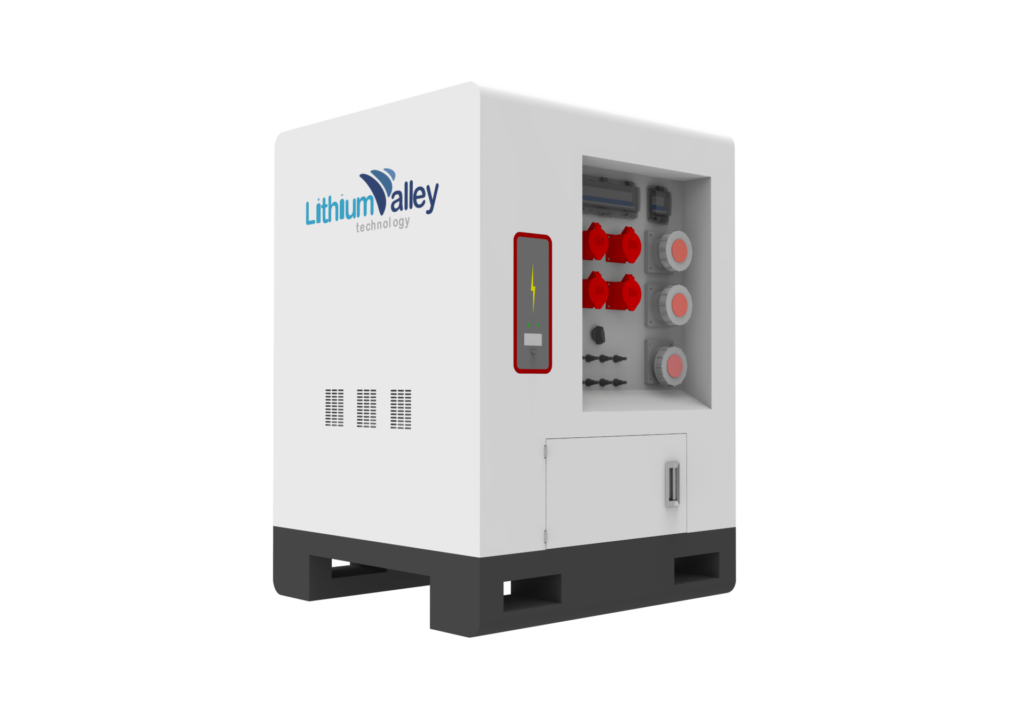
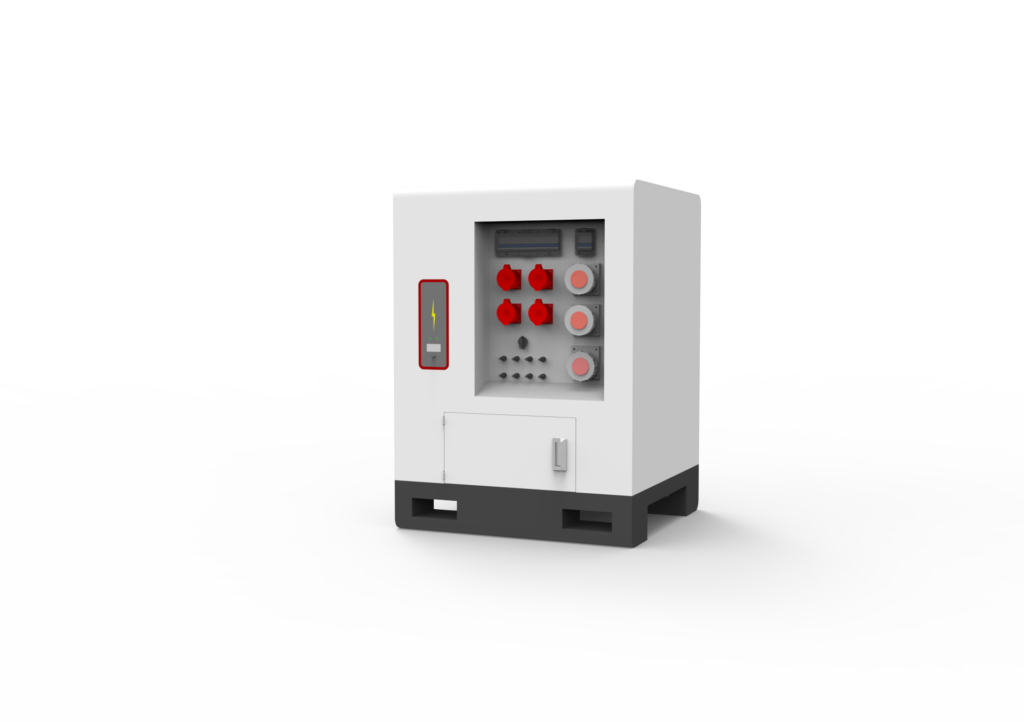
20 - 100 kWh
Mobile Energy Storage Battery
Experience unmatched overload capability of up to 200% and virtually maintenance-free operation. Tailored for optimal short cycle performance and offering a large usable energy range compared to other technologies, this battery ensures a low total cost of ownership.
Specification
Model

LV-MAST-T20K-A
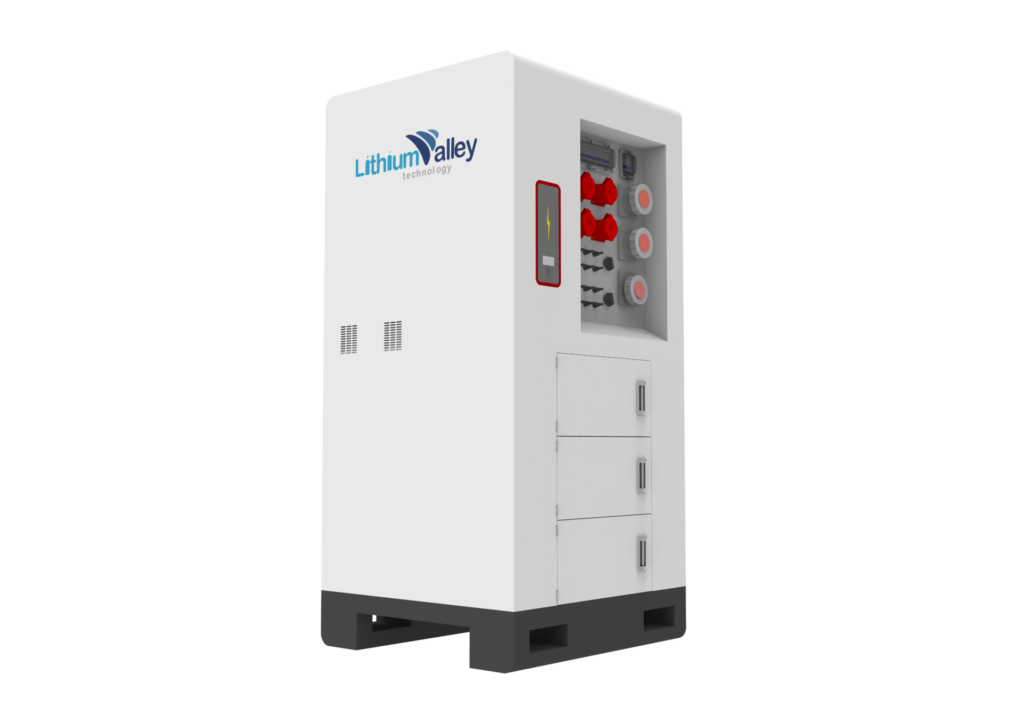
LV-MAST-T50K-A
Installation
Battery Voltage Range (V)
Max.Charging/Discharging Current (A)
Battery Configuration Capacity (kWh)
Phases
Battery Type
Cycle Life
Frequency(Optional)(Hz)
Max PV Input (kW)
Mppt Input Voltage (VDC)
Max.Input Current
Max.Short Circuit Current
Installation
160-233.6
100
20/40/60/80/100
Three Phases
LiFePO4
6000@80%DOD25C/0.5C
50/60
30
200-950
30A*2
40A*2
Installation
400-584
60
200-850
30A*4
40A*4
Structure
Dimension(W*H*D)(mm)
IP Rating
MaxPV Conversion Efficiency
Battery Part
900×850×1235
IP65
98.4%
Battery Part
900×850×1845
Ac Output(on Grid)
Rated Output Power (kW)
Rated output Current (A)
Grid Voltage (V)
Power Factor Range
Battery Part
20
33.5
Battery Part
50
83
3L/N/PE220/38230/400240/415
-0.8-+0.8
Ac Output(EPS)
Rated Output Power (kW)
Rated Output Current (A)
EPS Voltage (V)
Battery Part
20
33.5
3L/N/PE220/38230/400240/415
Battery Part
50
83
Specification
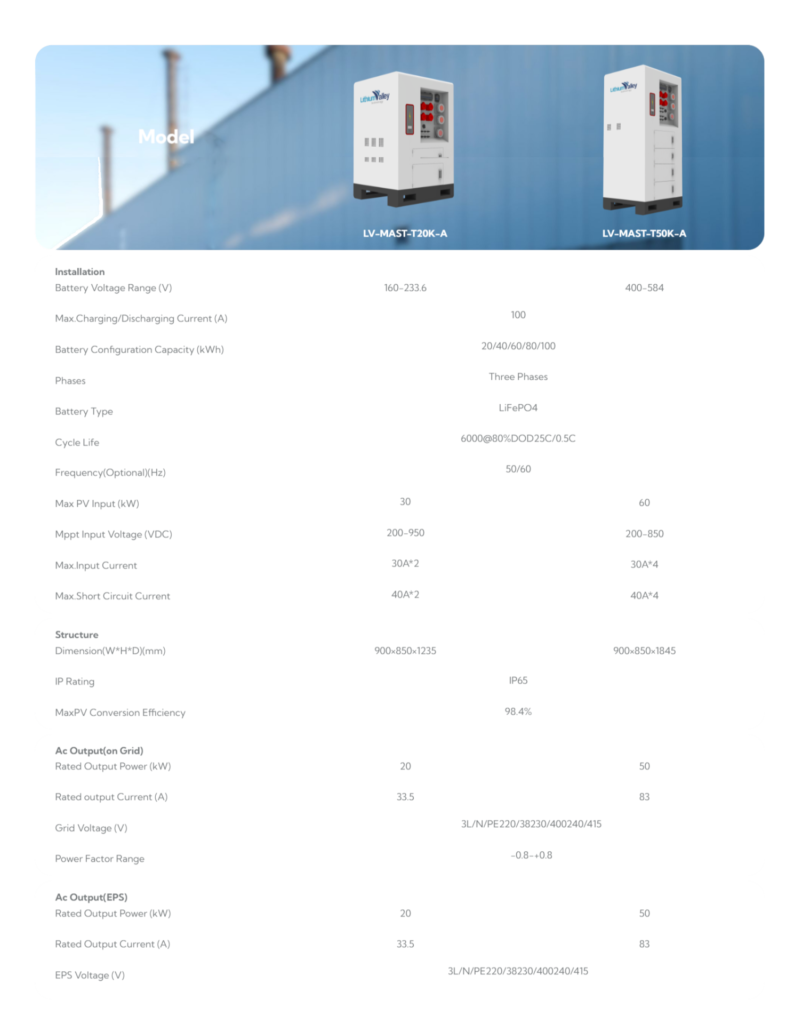
Similar Choices
Wall-Mounted Energy Storage Battery
51.2 V
5.12 kWh | 10.24 kWh | 15.36 kWh
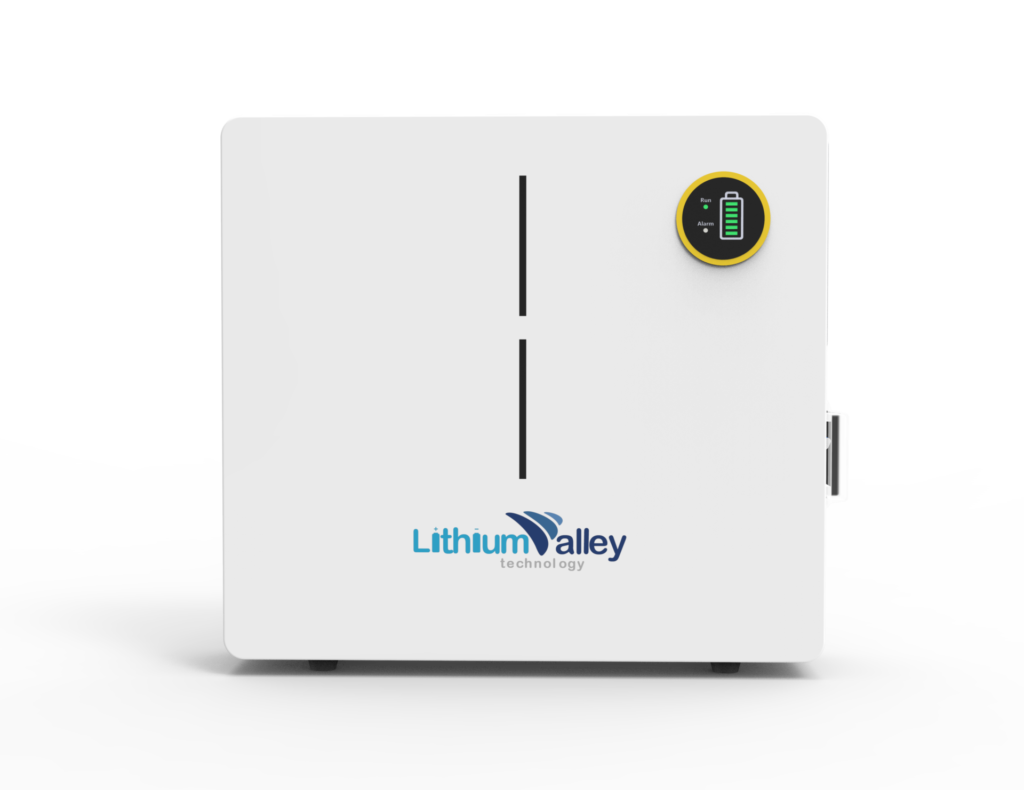
Stackable Energy Storage Battery
51.2 V
2.56 kWh | 5.12 kWh
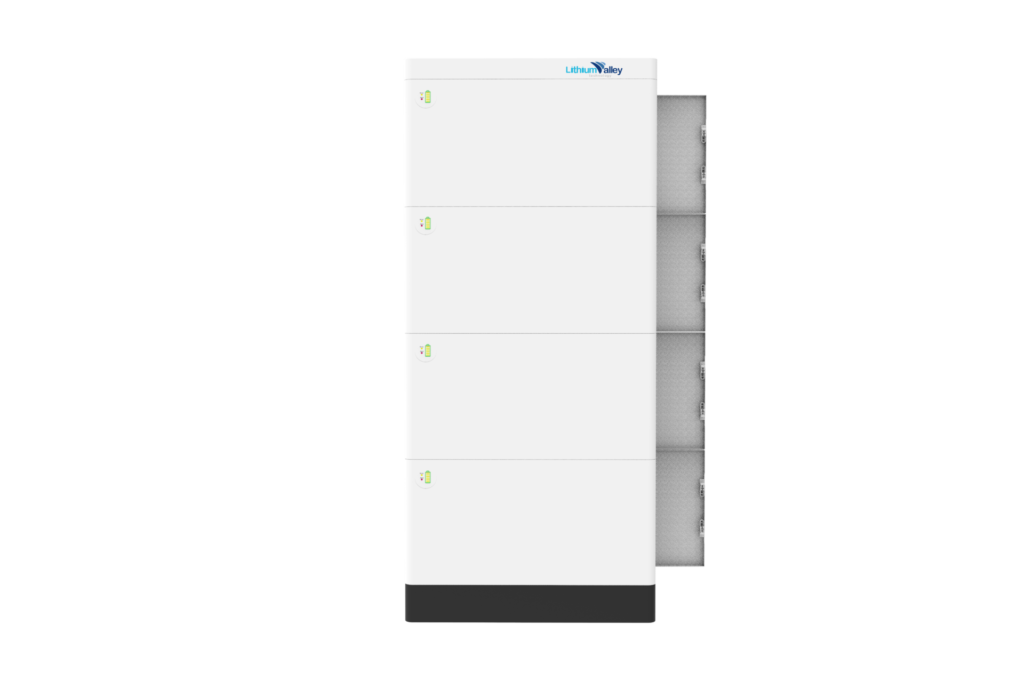
All-In-One Stackable ESS (EU)
51.2 V
10.24 ~ 30.72 kWh
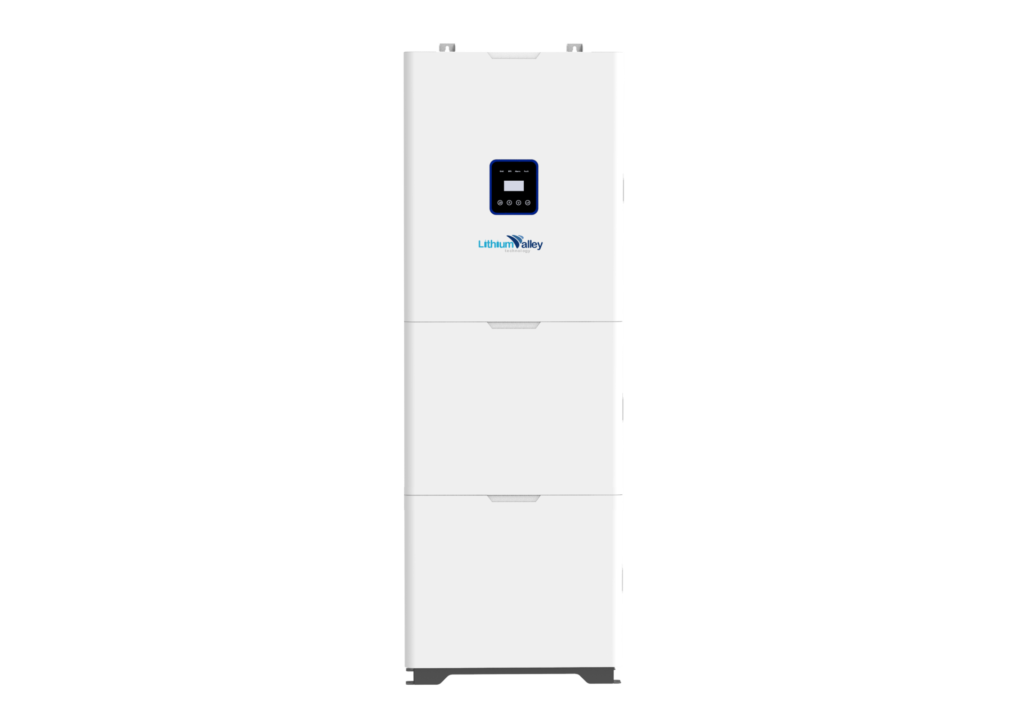
All-In-One Stackable ESS (US)
51.2 V
10.24 ~ 30.72 kWh
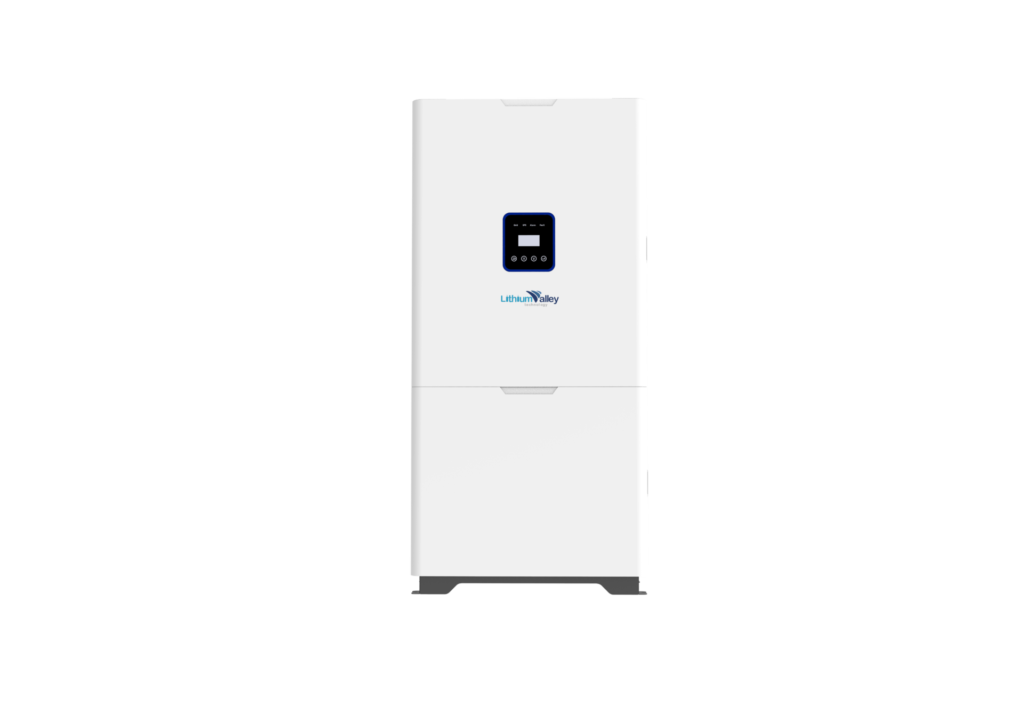
Q & A
To explore the possibility of becoming a distributor for our products, kindly send an email to [email protected] or click here directly. We would appreciate the opportunity to discuss this further. In order to better understand your business objectives, it would be helpful if you could provide information regarding your target market, the specific applications you intend to cover, as well as your annual expenditure. Thank you for your interest in partnering with us as a distributor.
We are committed to providing a comprehensive 5~10 years warranty for our products. Please refer to the enclosed warranty document for detailed information. In the event of any issues arising within the warranty period, provided the product has been used correctly, we will promptly provide new parts free of charge and guide you through the replacement process. If a product cannot be repaired, we will replace it with a new one at no cost. It is important to note that the faulty products must be retained at your location, as our engineers will visit to assist with inspection and repairs. We strive to ensure your satisfaction and appreciate your cooperation in this process.
The lead time for mass production can vary depending on the specific circumstances. If the product is currently in stock, the estimated lead time is typically 3-7 days. However, if the product is not available in stock, the lead time will depend on the quantity of your order. On average, it takes approximately 20-25 days for production. Please note that these timeframes are provided as general guidelines, and we will provide you with a more accurate estimate based on your specific order requirements. Thank you for your understanding.
To maintain the health of an LFP (Lithium Iron Phosphate) battery, there are several important considerations:
- Temperature: LFP batteries have a preferred temperature range of 4-35℃. Extreme temperatures, whether too high or too low, can negatively impact battery life. It is important to avoid exposing the battery to temperatures outside of this range.
- Frequency of Use: LFP batteries perform best when they are used frequently. If you anticipate using the battery less often, it is advisable to achieve a complete charge and discharge cycle at least once a month. This helps to prevent capacity loss and maintain optimal performance.
- Avoid Metal Contact: It is essential to avoid mixing the LFP battery with metal objects, especially in a way that could cause contact with the battery’s electrodes. If metal comes into contact with the electrodes, it can lead to a short-circuit accident, potentially damaging the battery.
- Appropriate Surroundings: The LFP battery should be placed in a clean, dry, and well-ventilated environment. It is important to avoid exposing the battery to corrosive substances and to keep it away from fire and heat sources. These precautions help to prevent damage to the battery and ensure its safe operation.
In addition to these considerations, it is worth noting that LFP batteries typically have a built-in Battery Management System (BMS) that helps monitor and protect the battery. The BMS helps maintain the battery’s safety and performance by monitoring its status and taking appropriate actions if any issues arise.
Investing in an Energy Storage System (ESS) may initially require a financial commitment, but over the long term, it can yield significant returns. Here are some ways in which ESS can help generate profit:
- Cost Reduction for Homes: ESS enables homeowners to reduce their electricity expenses by maximizing self-consumption of self-generated energy, participating in auxiliary services, and leveraging time-of-use optimization. Additionally, ESS can serve as an emergency backup power supply during major disasters or grid outages, enhancing the reliability of home power supply.
- Grid Support and Balancing: As the proportion of Volatile Renewable Energy (VRE) increases, there is a growing disparity between power generation and consumption patterns. By installing ESS, grid operators can effectively balance power generation capacity and demand, ensuring a stable and reliable grid.
- Participation in Grid Services: ESS can be leveraged to provide ancillary services to the grid, such as frequency regulation, voltage support, and peak shaving. By offering these services, ESS owners can earn additional revenue by selling excess energy or providing stability services to the utility.
It is important to note that the profitability of an ESS installation depends on various factors, including local electricity rates, incentives, system size, and usage patterns. Conducting a thorough analysis, considering specific market conditions, and consulting with industry professionals can help determine the potential financial benefits of installing an ESS.

The lifespan of energy storage batteries varies depending on several factors, such as battery type, usage cycles, and operating conditions. Here are some estimates based on the search results:
- Residential energy storage batteries can last anywhere between 5 to 15 years.
- The life expectancy of a solar battery is mostly determined by its usage cycles, and most solar batteries are generally deep-cycle batteries, which allows them to discharge up to 80% of their stored energy before recharging.
- The useful life of a battery is typically said to be at the end when it fails to meet around 60% of its nominal storage capacity.
- The timing of battery replacement or supplementation can be affected by the amount of system capacity overbuilt on the front end of a project.
It’s important to note that these numbers are estimates, and the actual lifespan of an energy storage battery will depend on factors such as battery type, usage cycles, operating conditions, and maintenance.
Lithium Valley ESS systems are protected by multiple safety levels for maximum safety. Safety features can include fire protection, overcharge protection, and temperature monitoring.
Lithium-ion batteries, which are commonly used in energy storage systems, can be a fire hazard if they are damaged or improperly installed. However, there are safety features that can help prevent fires, such as fire suppression systems and temperature monitoring.
Yes, it is possible for customers to connect LiFePO4 battery packs in parallel or series. However, there are important considerations to keep in mind to ensure safe and optimal performance:
- Parallel Connection: Before connecting batteries in parallel, it is crucial to ensure that their voltage and capacity are the same. If they are not identical, it is necessary to charge them at the same rate. Additionally, it is not recommended to connect a used battery with a new one in parallel, as this may reduce the overall capacity of the battery pack.
- Series Connection: If you intend to connect LiFePO4 battery packs in series, please provide us with the total capacity of the desired pack. This information will enable us to select the appropriate Battery Management System (BMS) for each battery, ensuring proper balancing and protection.
- Cautionary Note: If you do not have experience or expertise in handling parallel and series connections of batteries, it is advisable not to attempt it on your own. Mishandling the batteries can be dangerous and may also shorten the battery’s cycle life. It is always recommended to seek professional assistance or consult with our technical team to ensure a safe and reliable battery configuration.
By following these guidelines, you can safely and effectively connect LiFePO4 battery packs in parallel or series to meet your specific requirements.
When using I&C energy storage battery products, it is important to consider safety measures to prevent accidents and ensure the highest possible safety level. Here are some key safety considerations based on the search results:
- Check compliance with all relevant IEC and UL electrical safety installation standards, especially those that protect the device from polarity.
- Ensure safe integration of the module, rack, and containers.
- Invest in the right battery management system and energy management software.
- Use safe and standard-compliant components.
- Ensure that the battery management system (BMS) ensures the safe use of the battery.
- Install explosion prevention systems or deflagration venting if there are enough batteries in a room to create an explosive atmosphere.
- Follow safety standards for batteries and energy storage systems, such as ANSI/CAN/UL 9540.
- Ensure that the battery cells are compliant with the IEC62619 safety requirements for secondary lithium cells and batteries, for use in industrial applications.
- Follow safety and siting recommendations for large battery energy storage systems (BESS).
By following these safety measures, users can ensure that they are using I&C energy storage battery products safely and responsibly.
